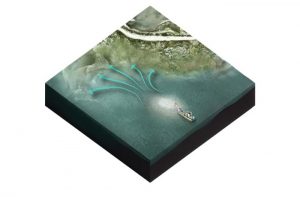Get Started
The strategic placement of dredged sediment in a shallow tidal environment can optimise the capacity for wind and waves to transport and disperse the material naturally to a desired location. Strategic placement of mud can be used to enhance ecological habitats, decrease turbidity and/or reduce the need to ship this material over a large distance thereby maximizing ecological benefits and minimizing costs. Throughout the world, there are locations that have too much fine sediment (causing a decline in water quality and high dredging costs) or a fine sediment shortage (for example sediment is needed to raise the land to compensate for sea level rise and is needed as building material for dike constructions and land reclamations). With strategically placing mud, we transform sediment from waste into a resource and contribute to the circular economy.
Fine sediment (mud) characteristics
Fine sediment (mud) is defined as having a grain size diameter smaller than 63 µm (as defined in The Netherlands; this threshold varies between countries). Fine sediment consists of silt (between 63 µm and 2 µm) and clay (smaller than 2 µm). Fine sediment is treated as a separate category from sand and coarser material because of its different properties and behaviour, which require a distinctly different approach for successful BwN design and implementation. The main characteristics of fine sediments are:
- Small grain size;
- Low settling velocity;
- Presence of clay particles, which have a large surface to volume ratio and are chemically active;
- Cohesive behaviour of the seabed and long-term consolidation, with implications for erosion behaviour;
- Flocculation and break-up of flocs in the water column, which influences settling and deposition behaviour.
Practical implications of fine sediment characteristics
These characteristics have the following practical implications:
- Transport dynamics. Fine sediment is mostly transported in suspension. In general, fine sediment is much more likely to be supply-limited rather than transport-limited such as is the case for coarser sediment, i.e. fine sediment transport often occurs much below saturation concentration. This implies that a different modelling approach is generally needed opposed to the ones used for modelling sand or coarse material.
- Density effects. At sufficiently high suspended sediment concentrations, its influence on water density may exceed that of salinity and temperature gradients. Turbulence may be damped and settling enhanced. In such ‘saturated’ conditions, near-bed fluid mud layers may be formed which strongly contribute to sediment transport.
- Contaminants. Because of the large surface area and chemical properties of clay particles, contaminants are often adsorbed to clay particles and may be transported. Therefore, pollutants are generally found in cohesive fine sediment deposits.
- Environmental impact. Because of the low settling velocity, and consequent tendency of remaining in suspension for a long time, fine sediment has direct implications on turbidity and underwater light climate. This is important to acknowledge as turbidity and light climate affect primary production and visibility for predators and prey.
- Deposition in low-energetic environments. Fine sediment tends to settle in sheltered areas such as harbour basins or tidal flats. In harbours, fine sediment contributes to siltation and hence increases the need for maintenance dredging. Instead, fine sediment contributes to mud accumulation on tidal flats, thereby increasing biodiversity. Fine sediment is therefore important for the ecological functioning of tidal flats and is ecologically (e.g. as foraging area of migratory birds), as well as economically (e.g. mussel beds and oyster reefs) beneficial.
Benefits
There are at least two reasons to promote fine sediment accretion:
- The more is deposited, the less is available in the water column contributing to lower turbidity and improved underwater light climate.
- The accreted area may provide valuable habitat for species such as plants or wading birds, thus increasing the ecological system value.
A sediment budget analysis should demonstrate the potential of these measures. If the objective is a local habitat improvement, small-scale measures may be effective. If the objective is an improvement on a system scale, the captured fluxes should be significant at this large scale. Only large-scale measures may thus be effective. Methods or designs to enhance sediment accretion include:
- Construction of salt marshes, see Enhancing salt marsh development: habitat requirements
- Introduction of local sheltering structures such as small islands, dams or vegetation;
- Agitation dredging.
The last method is meant to increase sediment supply, the other methods are meant to increase sediment trapping.

